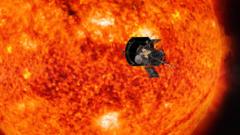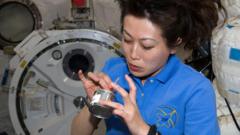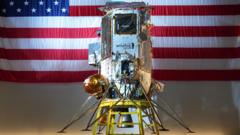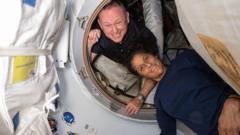The Parker Solar Probe is set to make a groundbreaking approach to the Sun's outer atmosphere, enduring extreme temperatures and radiation in a quest for understanding solar mysteries. Launching in 2018, this December fly-by marks its closest approach, just 3.8 million miles from the Sun's surface, prompting anxious anticipation from scientists.
Parker Solar Probe Makes Historic Dash Towards the Sun

Parker Solar Probe Makes Historic Dash Towards the Sun
NASA's spacecraft embarks on record-breaking journey to uncover the Sun's secrets.
The Parker Solar Probe, a pioneering spacecraft initiated by NASA, is embarking on an extraordinary journey to achieve the closest approach ever recorded to the Sun. As it plunges into the outer atmosphere of our star, it faces life-threatening thermal environments and intense radiation. During this daring fly-by, which spans several days, the probe will be out of touch with mission control; scientists are eagerly awaiting a signal on December 27 to confirm its successful navigation.
Dr. Nicola Fox, the science lead of NASA's project, emphasized the historical importance of this mission, stating, "For centuries, people have studied the Sun, but you don't experience the atmosphere of a place until you actually go visit it." The Parker Solar Probe intends to change that narrative as it makes its record-breaking approach on Christmas Eve, coming within 3.8 million miles (6.2 million km) of the Sun. In context, if the Sun and Earth were merely one meter apart, the probe would be just four centimeters away, an impressively close distance in astronomical terms.
To withstand the intense conditions, which include temperatures soaring to 1,400 degrees Celsius, the probe is equipped with an advanced carbon-composite shield that is 4.5 inches thick. However, speed is of the essence: the probe will be traveling faster than any human-made object at approximately 430,000 miles per hour—equivalent to a trip from London to New York in under 30 seconds.
The primary mission focus is to delve into the Sun's corona, the sun's outer atmosphere, which presents a long-standing scientific enigma. Dr. Jenifer Millard from Fifth Star Labs pointed out that while the Solaris surface is around 6,000 degrees Celsius, the corona reaches millions of degrees, raising questions about how the atmosphere is heating up. Additionally, researchers aspire to gain insights into solar wind—a continuous discharge of charged particles that can have significant impacts on Earth, such as disrupting communications and triggering beautiful auroras.
Amidst the excitement, NASA scientists face a nerve-wracking wait during the holiday season until contact is reestablished. Dr. Fox shared her confidence in the mission, stating, "I will worry about the spacecraft, but we really have designed it to withstand all of these brutal, brutal conditions. It's a tough, tough little spacecraft." The anticipation is high as humanity inches closer to unlocking the solar secrets, propelling our understanding of the Sun and its influences on our planet.




















